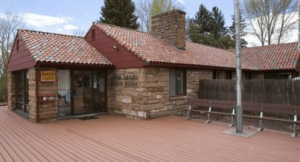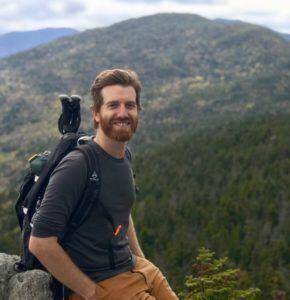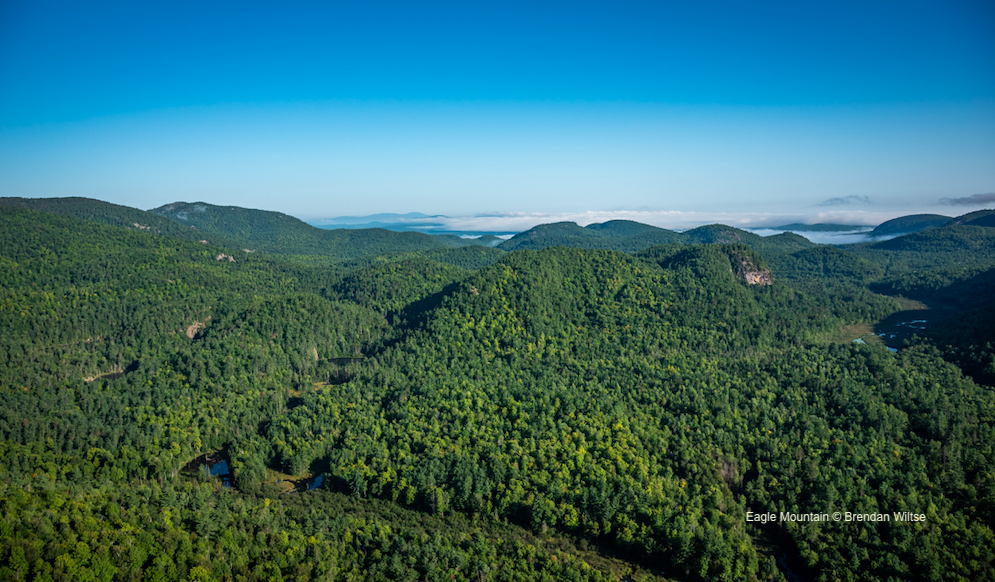
Eagle Mountain Success – A century-old tradition continues in New York’s Adirondack Park to solve the ecological crises of today and give us hope.
By Jon Leibowitz, Executive Director, Northeast Wilderness Trust
OLD FOREST
With the slap of her tail, the beaver formally welcomed us to her domain. She dipped back under the tannin-brown water, reemerged, slapped again, and zigzagged around her lodge. This river was her home, not ours; we were interlopers in her wild place.
We were six or so miles into a canoe trip up and down the Oswegatchie River within the Five Ponds Wilderness in the western Adirondacks. The Five Ponds landscape looks and feels different from most places across the northeastern United States, and for good reason. Within this New York State-designated forever-wild landscape remain approximately 50,000 acres of ancient forest. This expanse is recognized as the largest uncut forest in the Northeast. The river itself is lined with countless stately Eastern White Pines towering above 100 feet. The forests beyond host larger and older trees, everywhere, than I ever find, anywhere, in my home state of Vermont.
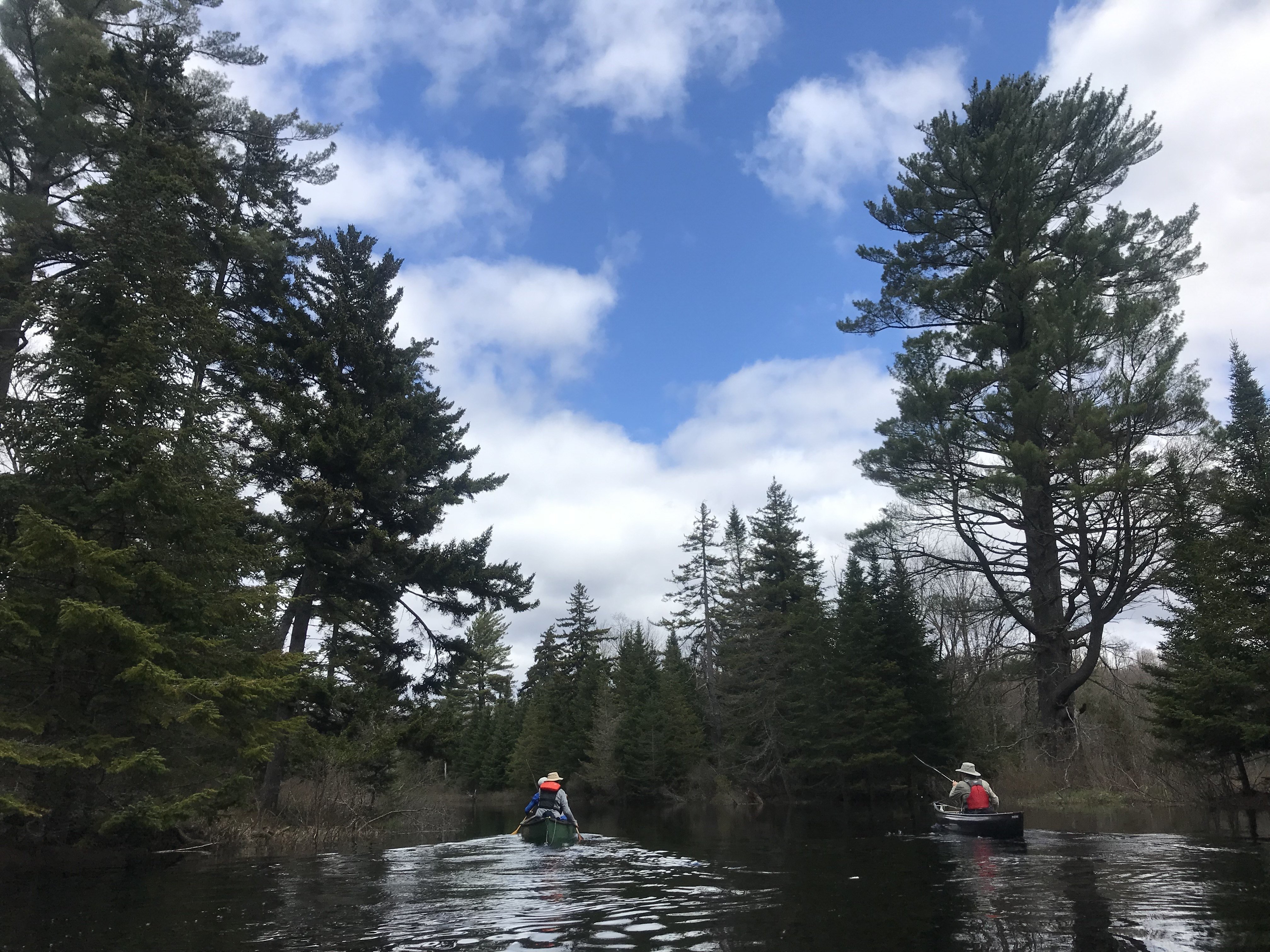
Five Ponds, Adirondack Park © Jon Leibowitz
A few days into the trip we turned off the Oswegatchie and paddled up an unnamed tributary. We made our way over beaver dams submerged under swollen spring waters, just barely passable without portage. As we meandered further up the watershed, schools of trout darted beneath my canoe through clear water bounded by sandy riverbeds. Eventually, the local engineers proved too successful and we parked our canoes just below a series of higher dams and headed off into the forest.
We began our walk amongst beautiful, old hardwoods. We passed the largest black cherry I have ever seen. Soon followed the largest yellow birch. What left me in awe was not the superlatives but the regularity and commonality of large trees—everywhere. Old growth, ancient, virgin, primary, primeval, pre-European; whatever one chooses to call it—looks and feels different from most forests across the Northeast. By some estimates, 99% of the forest across the vast Northern Forest has been logged—the remaining one percent is what’s left of the forest that stood before European arrival and the subsequent warfare upon forests.
After a snack, we left the hardwoods behind and crested an esker that stood between ponds. This heap of sediment and boulders, left behind by some ancient glacial event, afforded us a view in all directions. What lay before me was a forest that rivaled the “park-like” appearance of this continent’s stately western ponderosa forests (my former home) and California’s redwood groves. Towering white pines dotted the terrain in every direction, with many over 125’ by our estimation. One was too large for three grown men to wrap our arms around. Yes, it felt juvenile to hug the tree. Yes, it also felt thrilling, hopeful, and joyous.
Elder giants strewn across the forest floor by old age or tremendous storms created wide, clear walkways. It brought me right back to a college ramble through the redwoods many years ago, where giant round red bridges punctuated towering trunks reaching for the sky and lush green ferns carpeting the earth.
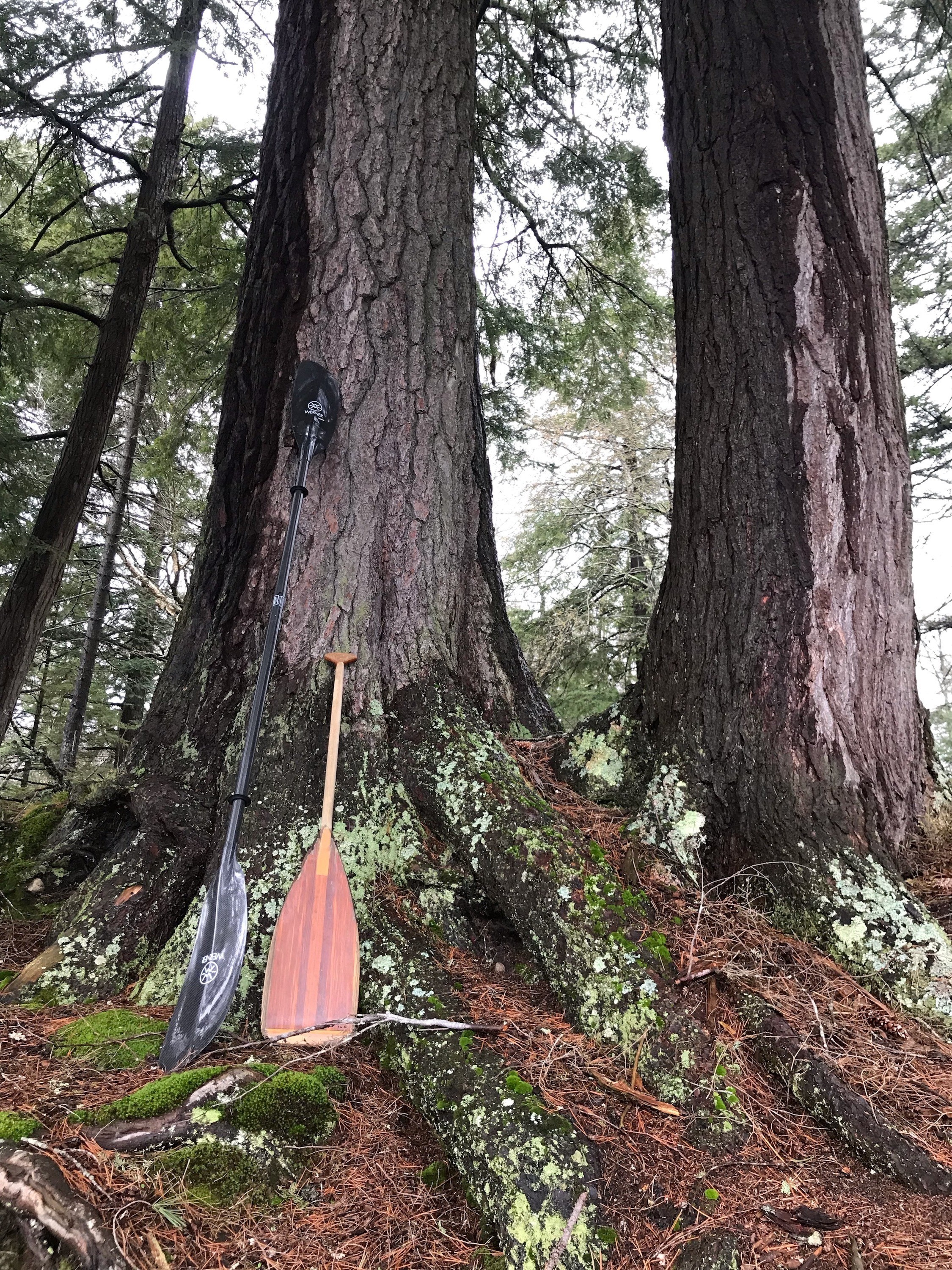
Five Ponds, Adirondack Park © Jon Leibowitz
Walking this forest was the first time in the Northeast that an experience in the woods evoked in me that feeling of wild magnificence, of old, grand, original forest; the same way I used to often feel tramping through wilderness areas out West. There is a definition for what constitutes old growth. It’s scientific and it likely makes sense to someone. I don’t know the precise point at which a secondary forest can be formally defined as old growth, nor do I care to know. What I do know, is that to me, ancient forests are self-apparent; I can feel it in my bones when I’m in one.
I left the Five Ponds with a full soul, a rejuvenated spirit, and an optimistic outlook on my work.
ECOLOGICAL AMNESIA
It wasn’t so long ago that most of the Northern Forest resembled the Five Ponds and rivaled western forests in splendor and size. It was not so long ago that witnessing a smooth-barked beech was the rule, not the exception; that flocks of passenger pigeons darkened the skies above the forest canopy; that catamounts stalked prey in a forest that stretched a third of the way across the continent. Nor was it so long ago that these rivers were the highways for annual migrations of millions of Atlantic salmon, American eel, and other diadromous species – a phenomenon that thankfully still continues in places like the Great Bear Rainforest of the Pacific Northwest.
Today the passenger pigeon—once accounting for 40% of the entire bird population of North America—is extinct. Catamounts have been extirpated from the Northeast. The cyclical, life-giving transfer of ocean nutrients hundreds of miles inland thanks to the migratory salmon and eels has functionally halted. The only sizeable Atlantic salmon populations today are raised in enormous, industrial offshore nets. Many of the regal Eastern White Pines like those along the Oswegatchie were cut for the Crown’s Navy centuries ago and a majority of the forest that stood upon European arrival was cut altogether by the late 1800s. Those original natural wonders brought richness to human life and great beauty and diversity to life itself. The absence of those missing denizens and grand eastern forests has become our collective baseline; the great forgetting. We all suffer from this ecological amnesia.
Before European “settlement”—read conquest–of America, there was no such thing as “old-growth,” no such thing as “native forest,” no such thing as “ancient forest,” because all of the forests were mixed old growth, they were all native, they were all diverse, ancient communities. Difficult as all of this may be to imagine, living as we do in this time of extraordinary ecological impoverishment, all of these images of fecundity are from near-contemporary accounts easy enough to find, if only we bother to look.
– Derrick Jenson, Strangely Like War: The Global Assault on Forests
The Northern Forest has changed and it continues to do so, both of natural and not so natural causes. We are born into an environment lacking apex predators, large trees, and landscapes with multi-generational communities of life. We lack deep understanding of and direct connection with the rhythms and laws of nature. It’s easy to accept that what surrounds us is normal. It isn’t.
The diminished has become our baseline; the empty, our cognitive reality, and the implications are drastic. With each generation that unwittingly accepts a less diverse planet as natural and normal, we collectively become more detached from the full diversity of life. As our original memory diminishes, it becomes ever harder to reimagine what the wild world should look like and what steps should be taken to rebalance our species with the planet; emotionally, physically, and spiritually.
A coral reef ravaged by climate change, bleached stone-dead as far as the eye can see, is unsurprisingly less inspiring than a reef overflowing with the psychedelic technicolor spectacle of thousands of species. Likewise, a northern hardwood forest of young spindly trees of the same age and diameter, devoid of stalking big cats and the full diversity of the land community, inspires one less than an old forest full of life. Less inspiration means greater apathy.
This ecological amnesia, or shifting baseline syndrome, may be one of the greatest threats to rebalancing our coexistence with natural systems. It’s predictable that fewer wander in and wonder at the natural world. It’s no surprise that more choose to escape into the digital world rather than the natural one. Those living today have been wholesale ripped off by those that preceded us! And, the cycle could continue in an endless negative feedback loop of more losses, more amnesia. But it doesn’t have to. There is a clear path to a more hopeful future.
TAKING STOCK OF WHERE WE ARE
The Adirondacks are perhaps the world’s greatest experiment in ecological recovery, a place hard used a century ago and now slowly recovering, slowly proving that where humanity backs off, nature rebounds.
– Bill McKibben
Over the past 100+ years, the Northern Forest has returned. These tenacious woods have proven their resilience. This recovery has followed two parallel tracks: the intentional and the accidental. The intentional track includes watershed moments like the creation of the Adirondack Park and the inclusion of forever-wild language in the New York Constitution in 1892; the creation of the White and Green Mountain National Forests in 1918 and 1932, respectively; the donation of land that became Baxter State Park in 1932; the passage of the Federal Wilderness Act in 1964 and subsequent Federal actions in 1975, 1984, and 2006 that designated significant portions of the Greens and Whites as Wilderness.
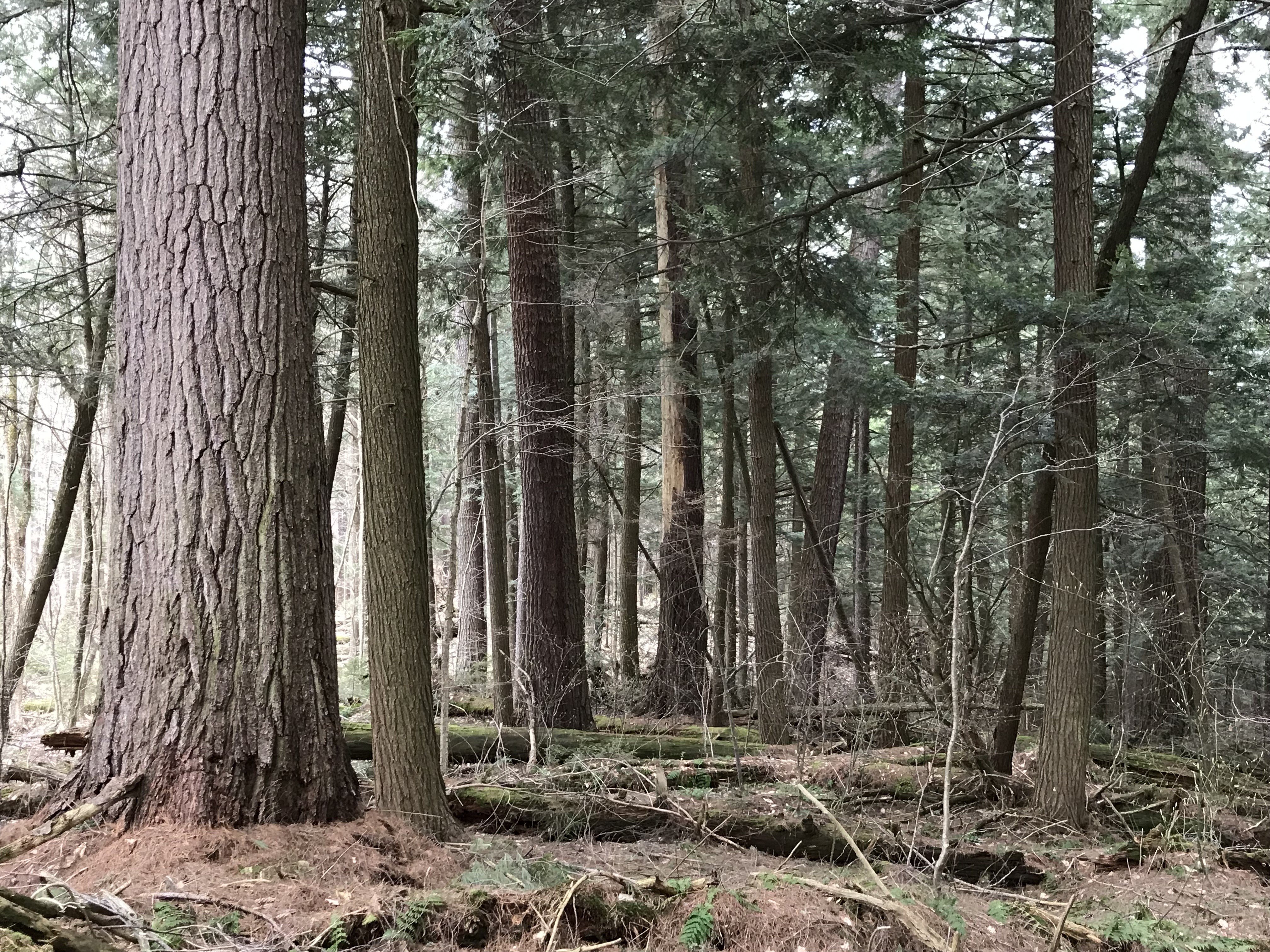
Five Ponds, Adirondack Park © Jon Leibowitz
Those intentional efforts are laudable, but as a region that is approximately 90% privately owned, arguably the more widespread occurrence has been the “accidental” rewilding of the region. This most fortuitous recovery resulted from the exodus of the dairy and wool markets in the late 1800s, as farmers fled west to gentler, more fertile ground. This economic shift was furthered by the abandonment of the charcoal industry, which petered out with the diminishing timber supply. With a sheer lack of humans, much of New England and the Adirondacks had a chance to rest and heal. As Mr. McKibben so aptly states, when we back off, nature rebounds.
The report from Harvard Forest, Wildlands and Woodlands, calls for 70% of New England (30 million acres) to be preserved as forest, and 10%of that (3 million acres) to be preserved as Wildlands. (New York is not included in the report.) We can celebrate the fact that the Northern Forest has largely recovered from its decimated state a hundred years ago. Thanks to the tireless work of the conservation movement, we are lucky that more than 25% of the region’s natural terrain has some sort of legal protection, largely from development. However, only about 3-4% of the Northeast is legally protected as forever-wild. Only such places—those with permanent forever-wild legal protections—are guaranteed to continue rewilding, growing old, and more complex. This is not nearly enough, and we have a long way to go before we reach 3 million forever-wild acres across New England
We are between two forested worlds–the natural forest of pre-settlement North America and the recovered forest of the future…The earlier forested world is not dead. We are studying and struggling to preserve its living remnants. And we do not believe that the future forest is powerless to be born. These remnants–with our help–will become the seeds from which a renewed forest spreads.
– Mary Byrd Davis, Eastern Old-Growth Forests: Prospects for Rediscovery and Recovery
Most protected forests in the Northeast have been preserved for people: for natural resource extraction, recreation, or motorized vehicle access. And that’s OK! However, it is within our power to change the ratio towards a more nature-centered future. The act of rewilding is to give land back to wildlife and wildlife back to the land. The Five Ponds Wilderness is a blueprint of a more hopeful future, not a relic of a distant past never to return.
REWILDING FORESTS and IMAGINATIONS by REIMAGINING WILDERNESS
Henry David Thorough wrote more than 200 years ago that, “In Wildness is the Preservation of the World.”
Today, in wildness is the tonic to our many modern ecological dilemmas. Wild places simply have a right to exist, but, let’s also acknowledge that rewilding and wilderness conservation in its historic context has been sidelined by the assumption that it is not relevant to vast segments of society. Today, that argument no longer holds water and a reimagining of what wilderness means provides tangible and measurable hope in an otherwise bleak state of ecological affairs.
Only through more forever-wild conservation can we unleash the full potential of our region’s carbon sequestering forests. Only through landscape-scale rewilding efforts can we stave off the biodiversity crisis. And, only through the humble act of setting aside vast and connected places that are left to their own devices will wonder and amazement be accessible to more people. Through rewilding, we can flip the script of ecological amnesia and create a positive feedback loop where more people connect with and care for wild places.
“You have to love something before you are moved to save it!”
-Sylvia Earle
In the 21st century, conserving the recovered woodlands of the Northern Forest as forever-wild is the most cost effective, scalable, and efficient tool in our arsenal to combat the interconnected crises of climate change and biodiversity loss. Such a new wilderness builds on the foundational ideas of the wilderness movement. When Howard Zahniser conjured up the language for the Wilderness Act in 1964, he knew that wilderness could grow as well as shrink, and he consciously used the obscure word “untrammeled” in the law’s definition of wilderness. The Wilderness Act does not contain the words “pristine” or “untouched.” Something that is trammeled is bound or caught; something untrammeled is free or unimpeded.
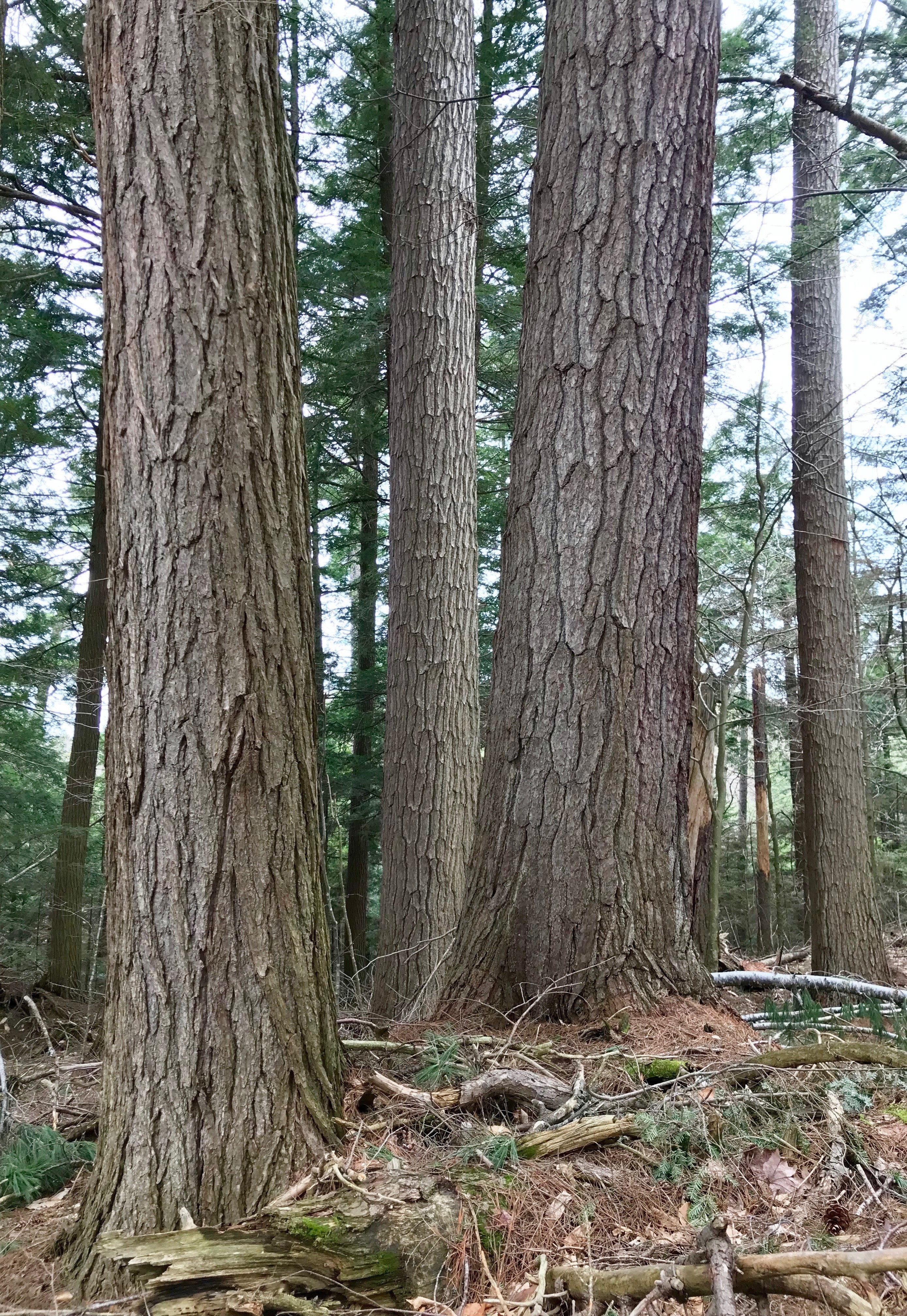
Five Ponds, Adirondack Park © Jon Leibowitz
Today, conserving wild places is about far more than setting aside land to remain untrammeled; it’s about our survival. Life itself hangs in the balance—human and non-human alike. We must celebrate that by recognizing such self-evident value, we are also helping ourselves. These ends are not mutually exclusive.
Backing off, rewilding, and reconnecting landscapes has been the work of Northeast Wilderness Trust since 2002. By applying the model of private land conservation to
the ideals of wilderness enshrined in the federal Wilderness Act and New York Constitution, the Wilderness Trust has helped conserve more than 35,000 acres of forever-wild landscapes across the Northern Forest. This has been accomplished through land acquisitions and forever-wild conservation easements. The Wilderness Trust’s guiding vision is that of a connected landscape of resilient wildlands shared by a human culture that deeply respects wild places.
The Wilderness Trust most recently purchased the Eagle Mountain Wilderness Preserve. The initiative to protect this place was featured in Rewilding Earth, and now that it has been preserved, not only from future development but also from extractive industries like logging altogether, it is growing wilder by the month. The Preserve is situated between two critical ecosystems—the fertile lowlands of the Champlain Valley to the east and the rugged High Peaks to the west. It is the latest in a two-decade long effort to conserve these transition lands. In the Split Rock Wildway to the south, the Wilderness Trust has completed nine transactions to protect the wildlife corridor. Eagle Mountain’s successful purchase expanded on this concept and helps secure connectivity in a critical corridor to the north. Acre by acre, parcel by parcel, this sort of slow but steady conservation is bring wildness and hope back to the Northeast.
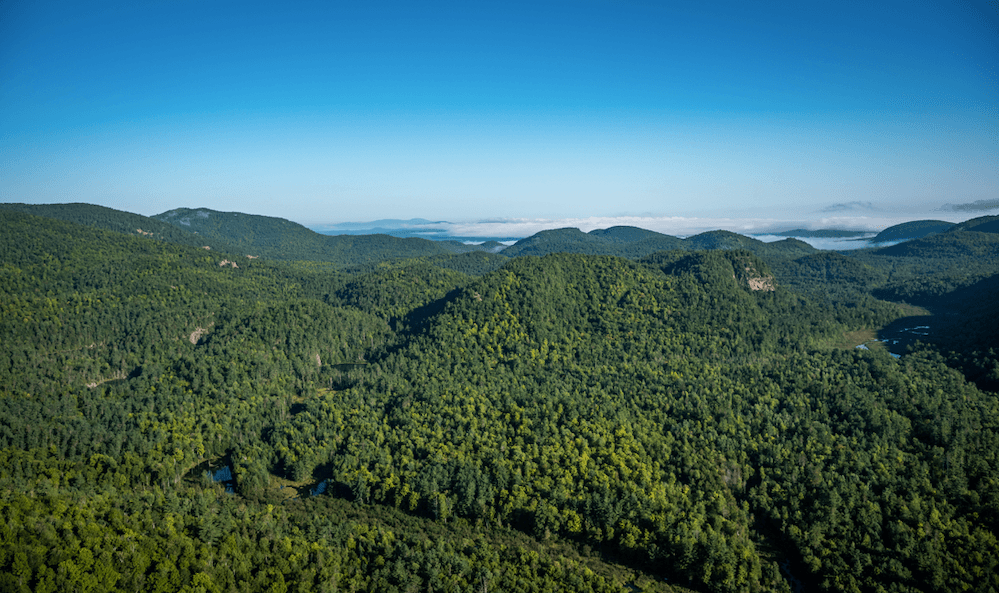
Eagle Mountain © Brendan Wiltse
Eagle Mountain is not pristine. It’s been heavily logged for a century. Old, grown-in timber roads crisscross the property. Yet, a wild character permeates this landscape. At over 2,400 acres, and sitting between two large conserved forest blocks, the property is quintessential Adirondack wildland. The strategically located parcel also conserves wilderness in an area underrepresented by conservation lands within the Adirondack Park, wilderness or otherwise. Beautiful ponds provide sustenance for otters, peregrine falcons nest on its cliffs, and mother bears raise their young among dense forests. The terrain teems with wildlife.
Much like the lands that Zahniser considered in drafting the Wilderness Act, Eagle Mountain is not untouched, but from the moment Northeast Wilderness Trust signed the deed, the land became untrammeled and the long process of rewilding began. At the Wilderness Trust, we say that wilderness is not simply a special kind of place, but rather a special commitment we make to a place.
No, Eagle Mountain Wilderness Preserve is not the Five Ponds Wilderness today, but on a small scale, it will be tomorrow.
WILDERNESS IS RELEVANT; WILDERNESS IS HOPE
As we consider the implications of a new wilderness for the 21st century and the hopeful reawakening of our collective connection with Wild Earth, places like Eagle Mountain can help lead the way. The property was purchased not for people, but for nature. It was protected so the forest could regain its original foothold and be self-willed, in every sense of the term. And in doing so, the benefits to people will be both measurable and immeasurable. Measurably, it will store carbon and provide safe harbor to wildlife. Immeasurably, it will rekindle imagination and wonder for generations of people to come. That in and of itself fills me with hope.
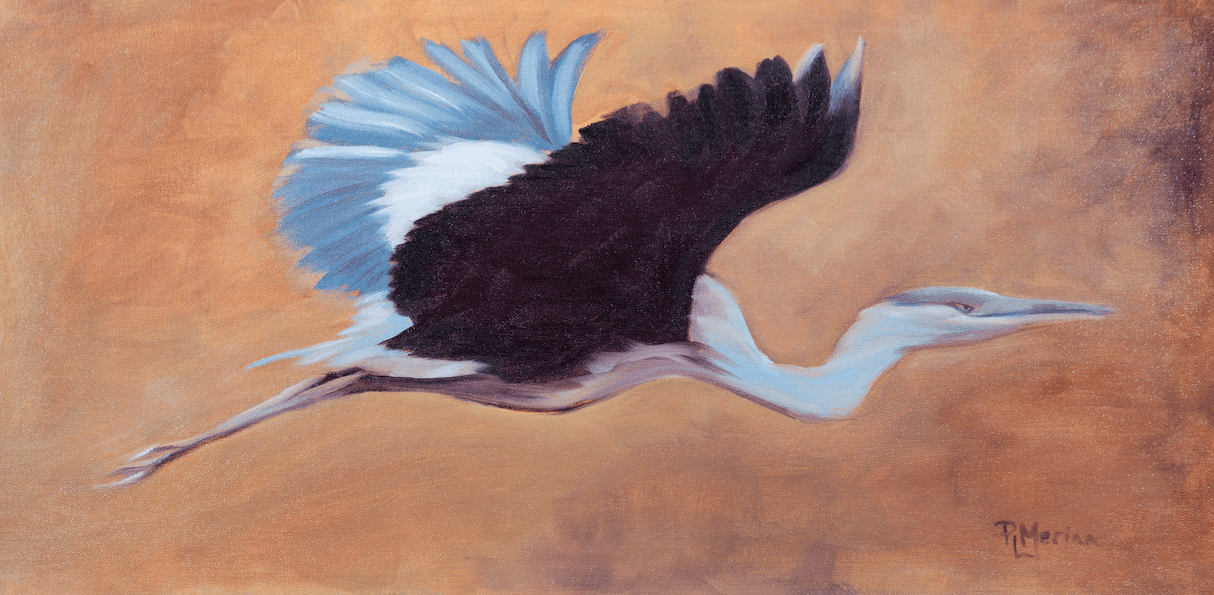
Flight: Blue Heron © Patricia Leahey Miriam
“Northeast Wilderness Trust’s Forever-Wild Circle of monthly donors is a community of the region’s most committed wilderness advocates and supporters. The Wilderness Trust is thanking Forever-Wild Circle members with custom bandannas, featuring the artwork of Patricia Leahey Meriam and hand-dyed with local indigo from Honey Hill Studios. Donating monthly is an effective and efficient way to ensure a forever-wild future for the land and wildlife of the Northeast. Your sustaining gift allows Northeast Wilderness Trust to focus its resources on the ground where our work matters most.”
____________________________________
Jon Leibowitz is Executive Director of Northeast Wilderness Trust – the only land trust in the northeastern United States focused exclusively on protecting forever-wild landscapes. He has worked in the private land conservation field since graduating from Vermont Law School in 2011 with a Juris Doctor and Masters in Environmental Law and Policy. Before joining Northeast Wilderness Trust, Jon was the Executive Director of Montezuma Land Conservancy, where he worked to conserve farms, ranches, and landscapes of pinion and juniper, ponderosa, and sage right on the edge of the Colorado Plateau, in Cortez, Colorado. Jon serves on the Board of Vermont Parks Forever in addition to being part of the Rewilding Leadership Counsel. He lives on the outskirts of Montpelier, Vermont with his family.

